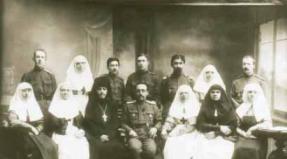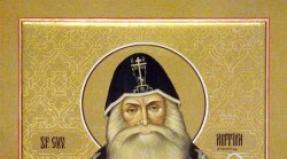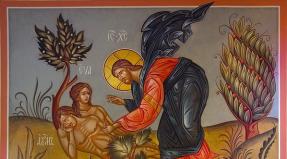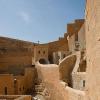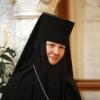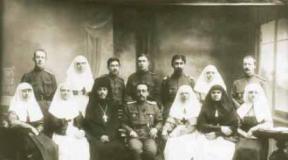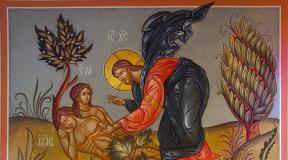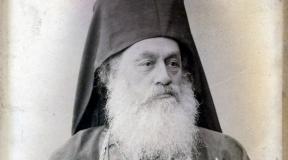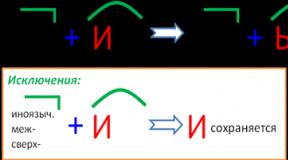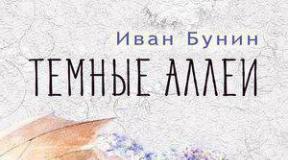“I loved all my obediences. Test of obedience. Abbess Philareta (Kalacheva) Pray to the saints and imitate them
Nun Philareta: “We believe that the monastery will be reborn in its former glory”
Nizhny Novgorod Holy Cross Monastery is one of the most remarkable convents in Russia. Before the Soviet era, it was widely known not only in our country, but also abroad; its walls saw many famous people and the highest government officials.
On September 27, the entire Orthodox world celebrates the Feast of the Exaltation of the Precious and Life-Giving Cross of the Lord. And for the Holy Cross Monastery this is also the patronal feast day of its main church. Nun Philareta tells our correspondent about today’s revival of the monastery’s former glory, its achievements and difficulties, what the great Feast of the Exaltation means for the sister community and how they celebrate it.
Mother, tell us what the condition of the monastery is today, how is its restoration progressing and what problems are you facing?
First of all, it is necessary to restore the material base of the monastery. Everything here is dilapidated: the floors in the buildings are rotten, the sewage system does not work, all communications need to be updated, and this requires a significant amount of time and money. To date, the territory of the monastery has been cleared of debris, a flower garden has been laid out, the monastery buildings have been whitewashed, and a new balcony for singers has been built in the cathedral.
The installation of five domes of the cathedral church is underway, and roof repairs are being completed. Now, perhaps, this is our most serious problem, because with the onset of autumn the rainy season is approaching and it is necessary to complete the work as soon as possible. There is particularly good news. Under the very altar of the monastery cathedral, in the crypt, there is the Church of the Iveron Icon of the Mother of God. It underwent restoration for two years, and is now ready for consecration. Restoring what was destroyed, the sisters set up a children's Sunday school in one of the buildings. The boys study the Law of God, the girls do handicrafts separately. An Orthodox medical center has been opened at the monastery, where priests and lay obedients receive help.
After reconstruction, about 100 nuns and novices will be able to live in the monastery. This requires, if possible, restoring the monastery within its historical boundaries. The authorities of Nizhny Novgorod promised to resolve this issue positively and help return the buildings that previously belonged to the monastery.
But the main thing is that by God’s providence our monastery again acquires great shrines. In the cathedral, for the worship of believers, a large crucifixion 4.5 meters high is displayed, which in 2005, on Good Friday in Jerusalem, was carried by a group of Nizhny Novgorod pilgrims led by Bishop George in the way of the Savior’s cross.
The monastery also received another shrine - a cross with a particle of the Life-giving Cross of the Lord, donated by the Bishop to the nuns of the monastery on the patronal feast day. A glorious tradition has been renewed: on Easter Saturday the miraculous Vladimir Icon of the Mother of God is brought to us from the Oransky Monastery.
The Holy Cross Monastery is located within the city. Perhaps this circumstance causes difficulties in the life of the monastic community?
With the growth of Nizhny Novgorod, the once secluded Holy Cross Monastery has found itself in the very center of Nizhny Novgorod, and this, of course, causes difficulties. But still, the location of the monastery is wonderful. The place that the monastery now occupies was called “true” and “blessed” by Bishop Moses at the beginning of the 19th century. And indeed, although the bustle of the city is two steps away from us, silence, calm and prayer reign outside the walls of the monastery.
It is important to note: despite the fact that our sister community moved from the Conception monastery to the Origin monastery, and then to the Exaltation of the Cross, it always maintained unchanged its charter, established by its founder, Blessed Theodora.
This charter constitutes the spirit of our community, no matter within what walls we reside, no matter where we are. Blessed Theodora, whom we sacredly honor, sets an example for our sisters and for all women in general of humble service to God and people, abandonment of vain glory and wealth.
The upcoming Feast of the Exaltation of the Holy Cross is certainly significant for the Holy Cross Monastery. How do you celebrate it?
“The cross is the guardian of the entire Universe, the cross is the beauty of the Church, the cross is the power of kings, the cross is the affirmation of believers, the cross is the glory of angels and the plague of demons,” this is how one of the church hymns explains the meaning of the cross. Through the cross, the Kingdom of Heaven was revealed to people, and therefore the resurrection to eternal life.
The pages of the Old and New Testaments repeatedly report on the saving effect of the cross; since ancient times the Church has chanted: “Lord! Weapons against the devil You gave us Your Cross.” Our entire monastery and its main temple are dedicated to the historical events that formed the basis of the Feast of the Exaltation of the Cross. For the Holy Cross Monastery and its sister community, this holiday, like the day of an angel for every person, is comparable to the Resurrection of Christ and the hope of salvation. In pre-revolutionary times, many people flocked to our monastery for the Exaltation, the service was performed with special solemnity, and after the liturgy a festive dinner was organized for all those who came. Today we strive to revive what was lost, therefore on this day we would like to see as many believers as possible in the monastery cathedral.
Particularly gratifying was the participation in the festive service of students of the medical college and children from the neighboring boarding school, which has become a tradition. Since I first crossed the threshold of the monastery three years ago, there has always been a treat here on the Feast of the Exaltation of the Cross, and joy and love reign among the people gathered for prayer.
From the editor: we inform everyone who wants to help in the revival of the glorious Holy Cross Monastery the address of the monastery and its bank details.
603022, Nizhny Novgorod, Oksky congress, 2 A, tel.: 433–92–25, 433–76–85
INN 5262043748 KPP 526201001 r/s 40703810700820000145
BIC 042202772, CJSC "Nizhegorodpromstroybank",
Kanavinsky district of N. Novgorod, contract number 30101810200000000772
Do you lie that all the wealth, envelopes and gifts, residences and jewelry that come to our successor apostles do not serve their personal comfort, consumption and enrichment?
Everything, they say, remains to the church. Well, perhaps a little bitten and abused.
Well, the truth has come to light about a piece of the personal savings of His Holiness Alexy.
And she surfaced exactly on the memorial day.
For some reason, God determined that this truth would come out precisely on this day of habitual drooling.
Even in the morning, the press secretary of the current Holy One, concerned that his Holy Leader was greatly inferior to his Predecessor in popular opinion, called for a reduction in the degree of hypocritically nostalgic sighing about the Holy past.
(Volkov from Paris: “I can’t keep silent. I see in the feed on today’s memorable day of the death of His Holiness Patriarch Alexy some kind of inexpressible melancholy, the heaviness of words and photographs. As if with his death all good things ended, everyone forgot about his deeds and about him personally and in general there is impenetrable darkness ahead, but this is how everything was spiritually before. Friends, what are we talking about?"
https://www.facebook.com/profile.php?id=100000929212448&fref=ts)
By evening, Heaven gave an answer to Volkov’s obsequious vanity through the mouth of the Arbitration Court.
Alexy's stash worth 300 million rubles was found.
But he is not a fool to keep all donations and labor savings in one basket and in one country. There are also foreign accounts. And one more note: we do not know how much money the heiress withdrew from these accounts in the 8 years that have passed since the death of the testator. We only know how much is left at the minute the bank collapses.
But why he, or even his successor, would need that kind of money is something I can’t understand with my mind. The patriarch lives “under communism.” He holds the post for life. Clothes, vestments, utility bills, food and premium transport - everything is free and for life. There are no children of their own (?), distant relatives have already been well provided for for a long time. Every day they bring him new gifts and envelopes. At the same time, he has completely uncontrolled access to any church accounts.
Why, in such a situation, multimillion-dollar and ever-increasing personal nest eggs? This is the purest example of pure beauty. An example of captivity by passion.
And yet the language, which habitually calls on others to live in modest poverty and asceticism, has never faltered...
During her lifetime, Philareta always called her millionaire employer “Holy.”
Okay, let's read the press:
“According to the materials of the Moscow Arbitration Court, in the accounts of Vneshprombank, whose license was revoked at the beginning of 2016, the personal savings of the late Patriarch of Moscow and All Rus' Alexy II (Alexey Ridiger) were kept. Now they are claimed by the heiress of the patriarch - the abbess of the Moscow courtyard of one of the Estonian monasteries of Alexandra Smirnov (Abbess Philareta), who has been Ridiger's closest associate since the mid-1960s.
The heir to the fortune of Patriarch Alexy II (Alexey Ridiger), 80-year-old Alexandra Smirnova, filed an application with the Moscow Arbitration Court demanding that she be included in the list of creditors of Vneshprombank (the license was revoked in January 2016). It was there that there were accounts containing the personal savings of the late patriarch with a total amount of about 300 million rubles - 2.92 million dollars, 8829 euros and 9.37 million rubles; Smirnova demands that just over 305 million rubles be returned to her.
According to court materials (available to Meduza), Ridiger made a will back in 1976, appointing Alexandra Smirnova, a native of the Yaroslavl region, as his heir. As a source in the Russian Orthodox Church told Meduza, Smirnova, in spiritual life - Abbess Philareta, was the patriarch's closest associate, who spent more than 40 years next to him. Now Philareta is the abbess of the Moscow courtyard of the Pyukhtitsa Holy Dormition stauropegial (that is, subordinate directly to the patriarch) convent, located in Estonia.
In her book “Abbess. For holy obedience” Philareta (Smirnova) recalled that she entered the Pyukhtitsky monastery in 1956, when she was 20 years old. And ten years later, in 1966, Filareta and her cellmate were sent to obey the future patriarch - then Alexy was the Archbishop of Tallinn and Estonia, as well as the manager of the affairs of the Moscow Patriarchate. “Then I began to come to Pyukhtitsa, accompanying [Alexy],” wrote the abbess. It is interesting that her book was published in 2013 with the money of a major trustee of the Pyukhtitsa Monastery, Maxim Liksutov, who has headed the Moscow Department of Transport since 2012.
In 2005, in an interview with Gazeta, Alexy II said that obedience at the patriarch’s residence is carried out by nuns from the Pukhtitsa Holy Dormition Convent. “They are led by Abbess Philareta, who has been running the farm for over 40 years. She selects the household staff,” said the patriarch. It was Philareta who was the first to learn about the death of Alexy II - she found the patriarch dead on December 5, 2008.
In court against Vneshprombank, the interests of Abbess Philareta are represented by lawyer Kravtsov. He also represents the interests of the co-chairman of the Union of Orthodox Women of Russia, Anastasia Ositis, at the trial. She met Abbess Filareta and the future patriarch back in the 1970s in Estonia. Anastasia Ositis and her daughter Irina Fedulova were shareholders of Vneshprombank at least until 2008. The Ositis reception declined to comment."
“The Moscow Arbitration Court, at the request of the heiress of the late Patriarch Alexy II, Alexandra Smirnova, decided to include in the register of creditors’ claims the inheritance “stuck” in Vneshprombank in the amount of almost 300 million rubles, it follows from the court materials.
However, the temporary administration introduced at the bank established that as of January 21, 2016, assets actually amounted to only 40.43 billion rubles, with liabilities amounting to 250.55 billion rubles, RIA Novosti reports.
Alexy II (Alexey Ridiger), according to the case materials, made a will for Alexander Smirnov back in 1976. The inheritance, as of 2009, consisted of two dollar accounts, an account in euros and an account in rubles. The principal amount was kept in dollars.
Smirnova filed a lawsuit to recover the equivalent of 305.6 million rubles from the bank. However, the court found the demand for only 297.5 million rubles justified.”
http://vz.ru/news/2016/12/5/847678.html
And again we listen to Fr. Vsevolod:
“The bishop has practically nothing extra, he cannot pass on anything by inheritance, because he has nothing in particular, he cannot pass on anything to his brothers or sisters, or anyone else like that. A priest usually has personal property.”
I won’t cling to the word “superfluous”. Perhaps this is a printing error and refers only to the bishop's "personal" property.
Alas, here too Fr. Vsevolod is telling a lie. Bishops of the Russian Orthodox Church, as a rule, have an excess of personal property. So I go out into the courtyard of my Moscow church and can show with my finger the houses (within direct visibility) in which six bishops have their completely private apartments (and four of them are in one house).
During the time known to me, one of them retired - and from a distant diocese moved to live in this particular Moscow apartment. During the same time, two of my other bishop neighbors changed their sees - and the bishops who were appointed to their former sees did not move into their Moscow apartments. Yes, none of these bishops are Muscovites. These are precisely the apartments they acquired during the years of their episcopal service.
The rationale is simple: a) you never know how my relationship with the patriarchy will develop - I must have at least some kind of economic independence from it; b) it is not right for a bishop to live in a Moscow hotel, where he can run into prostitutes. I don’t know what doesn’t suit them about the two patriarchal hotels in Moscow (“Danilovskaya” and “Universitetskaya”).
Therefore, quite often the path of expansion of a bishop’s personal real estate is as follows: an apartment in a diocesan city – a house in the suburbs – an apartment in Moscow – real estate abroad. Everything is like people. Well, those of them who belong to the upper class in terms of their income and consumption standards.
But you still need to help your loved one. The list of relatives who improve their living conditions for the light of their Eminence relative can be quite wide.
And sometimes it’s quite interesting: one pious elderly provincial bishop collects funds from the priests and transfers them to his beloved niece - she needs a lot of money to make a career as a pop singer in Moscow.
(December 5, 2016 it was clarified to me: The bishop collecting for his pop niece is called Panteleimon, Yaroslavsky and Rostov (Dolganov), whom you, father, remember classifying as non-covetous a couple of years ago, when he was strangely robbed during his vacation... And there is no end or end to this. And first one, then another priest will say in their hearts: “How long?” then it has turned into its opposite, where no one has the right to anything, and will soon cease to have any claim").
Chaplin likes to say that bishops are childless, and therefore they have no heirs. Which, in his opinion, means that all their property is not personal. Well, I’m ready to live under such communism: everything will be brought to me according to my desire, everything will be serviced not at my expense. I just can’t bequeath anything. Cars, a driver, servants... Yes, this is even tastier than having it as purely personal property: none of it gives me a headache.
By the way, oysters eaten by an ordinary rich person cannot be passed on by inheritance either. As well as the money he spent on the cruise voyage. Or all kinds of services. Or cars he bought not in the last 2-3 years of his life. So, let’s not consider all this as luxury goods?
So the ability to bequeath something cannot at all be a criterion for whether it is compatible with declared asceticism or not.
Bishops are excellent at converting even diocesan property into their own. If, when moving to another diocese, the outgoing bishop left his successor a diocesan vehicle fleet, this does not look like a rule, but like a miracle.
They know how to store the eggs they accumulate in different baskets.
Once our bishop abroad received an order from the Patriarchate to restore his cathedral for the anniversary. They gave him an order, but they forgot to transfer the money. And his diocese was indeed poor. Then this ruler decided to turn to the Greek bankers. They happily came to the dinner party. But while the bishop was delivering a long speech on the topic of Slavic-Hellenic friendship and pan-Orthodox brotherhood, the bankers quietly, silently and bowing deeply, left. Tradition says that by the end of his speech, only one banker remained in the hall. The Bishop asked him: “Did I say something wrong? Why did they leave? To which his interlocutor replied: “Vladyka, dear, you said everything wonderfully! The 5-6 million dollars that you are asking for is, in general, a small amount for us, and we could very well give it to you. But we are bankers. We know who holds what money in our banks. Believe me, Vladyka, your Moscow bishops keep such funds in our banks that the amount you ask for is completely insignificant. So ask yours!”
I will also note that bishops, as a rule, set a small official salary for themselves - in order to exclude requests from their subordinate employees of the government to increase their salaries (even Patriarch Alexy once responded to my request in exactly this way). Like, you can’t get more than me! The fact that the bishop does not live on his salary at all is taken out of the equation. Accordingly, they do not make all their personal expenses out of what they earn. This is the case when “state” wool is, in principle, indistinguishable from personal wool. And this means that the personal real estate they purchase is a waste of church money. The money that the priests took from their families and their parishes.
One more nuance: the precious episcopal vestments, accumulated by the bishop throughout his life, are usually not inherited by anyone. Is it possible to see the vestments of Patriarch Alexy on Patriarch Kirill? No - everything is brand new (the only exception is the enthronement red vestment, which is taken out once a year on the day of celebrating the anniversary of the enthronement).
... After the death of Patr. Alexy, a commission was created to inventory his personal property. There was a lot of work (money-grabbing was not alien to the deceased). Everyone is tired. And already at two o'clock in the morning, suddenly a box filled with panagias is found under his bed. Everyone looks at each other in horror: describing each little thing separately is an extremely long process. Then Vladyka Arseny pushes the box back under the bed with his foot and says to the secretary: “Write: “box with panagia!” This act of Vl. I find Arseny quite humane.
But where is the promised publication of the diary of Patriarch Alexy? What is the fate of his accounts and assets? Silence.
***
I- Episode 1 of “The Young Pope”:
Vatican confessor says:
- I am well. The only problem is with the hair.
- Do they fall out?
- They hurt.
***
Today the patriarch is honored,
And tomorrow suddenly - a portrait in a sad frame.
Well, I think he won’t all die:
The soul will remain.
And an account in Sberbank...
The Orthodox Church is a hierarchical and conservative structure. Management functions in it have always belonged to men - primarily to the episcopate and the clergy. And yet, in the life of the Russian Orthodox Church, women have played and continue to play a very definite role.
. Text: "Tatiana's Day"
On the eve of March 8, we tried to compile something like a list of those women who, if they do not take part in the decision-making process in the Russian Church, then at least perform some managerial functions.
This material is compiled based on data from open sources and does not take into account a number of factors that affect the degree of influence of a particular candidate. We deliberately do not use the word “rating” as a term that contradicts the church’s understanding of the ideas of hierarchy and service, which is based on the words of the Apostle Paul: “Everyone remain in the rank in which they are called”(1 Cor. 7:20).
In addition, we deliberately avoid analyzing the influence of women in church circles - the spouses of prominent government officials who take an active part in the work of various charitable organizations, provide support for church social projects, etc. A striking example of such influence can be, for example, the wife of the head Russian government Svetlana Medvedeva.
Also left out of our attention will be women who undoubtedly influence the agenda in the church community, but do not belong to official church structures. Such persons include, for example, famous journalists Elena Dorofeeva (ITAR-TASS) and Olga Lipich (RIA Novosti), specializing in religious topics, editor-in-chief of the website “Orthodoxy and Peace” Anna Danilova, former editor-in-chief of “Tatiana’s Day” , journalist Ksenia Luchenko, as well as Olesya Nikolaeva - poetess, writer, laureate of the Patriarchal Literary Prize.
This could also include the leaders of the “Union of Orthodox Women”, a public organization established in 2010: Nina Zhukova and Galina Ananyeva, who are also members of the Bureau of the World Russian People’s Council, as well as Marina Belogubova, head of the Department of the Office of the Plenipotentiary Representative of the President of the Russian Federation in Central Federal District.
We will deliberately limit ourselves to the official church governing bodies and consider the candidacies of those women who are members of these bodies.
In general, the degree of influence of a particular woman in the structures of church governance can be assessed from two points of view. Firstly, from a strictly hierarchical position. For a female nun, the highest career achievement is being abbess in a stauropegic (directly subordinate to the Patriarch) monastery. Therefore, automatically all the abbess of stauropegic monasteries were included in our list. Secondly (and this approach seems more correct), this assessment can be made from a purely functional position, that is, from the point of view of a woman’s involvement in the actual activities of the administrative or advisory structures of the Russian Orthodox Church. And it is for this reason that the list is not limited to the abbess of large monasteries.
The opportunity to personally consult with the Patriarch on a particular issue is a privilege enjoyed only by the most authoritative women in the Church. Photo Patriarchia.ru.
In the latter case, the main indicator will be the participation of women in the work of the Inter-Council Presence - “an advisory body assisting the highest ecclesiastical authority of the Russian Orthodox Church in preparing decisions concerning the most important issues of the internal life and external activities of the Russian Orthodox Church”(see Regulations).
In accordance with the Regulations, “The Inter-Council presence is called to discuss topical issues of church life, in particular those related to the sphere of theology, church administration, church law, worship, shepherding, mission, spiritual education, religious education, diaconia, relations between the Church and society, the Church and the state, the Church and others confessions and religions." That is, the range of issues discussed includes almost all aspects of the life of the Russian Orthodox Church.
In light of the steps to reorganize the system of church governance initiated by Patriarch Kirill in recent years, it is participation in the real process of discussing topical issues of church life (which, according to the Patriarch’s plan, should take place within the framework of the activities of the Inter-Council Presence) can be an indicator of the actual influence of one or another persons.
Let us note once again that the sampling results for these two parameters do not always coincide, i.e. the abbess of the largest stauropegial monasteries are not necessarily members of the Inter-Council Presence. Among the 11 women currently included in this body, five are abbess of monasteries (and only three of them run stauropegial monasteries), one nun and five laywomen.
It is worth noting that in addition to the Inter-Council Presence, a structure created not so long ago, the Russian Church currently maintains a system of synodal departments. By analogy, which is clear to the secular reader, synodal departments, committees and commissions are usually equated to “civil” ministries. The structures of these departments also include women—mostly abbess of monasteries. The practice that has developed in recent years - when the commissions of the Inter-Council Presence and synodal departments deal with the same issues of church life, and sometimes are called almost identically - introduces a little confusion into this study. For example, several female abbesses of monasteries are members of the “profile” commission of the Inter-Council Presence, which is called the “Commission on the Organization of the Life of Monasteries and Monasticism”; and in parallel, almost all of them, plus several more abbesses, are members of the Collegium of the Synodal Department for Monasteries and Monasticism.
But even a superficial glance at the composition of both structures indicates that the participation of women in the work of the Inter-Council Presence is undoubtedly much more representative and active than their work in church “ministries”. Therefore, we will build primarily on this indicator.
In terms of formal status within the framework of the activities of the Inter-Council Presence, the greatest weight has Abbess Juliania (Kaleda), abbess of the Moscow Conception Monastery: she is the only nun who is a member of the Presidium of the Inter-Council Presence. In addition, she acts as secretary of the Commission on the Organization of the Life of Monasteries and Monasticism, and is also a member of the Collegium of the Synodal Department for Monasteries and Monasticism.
Abbess Juliania (Kaleda)
In the world - Kaleda Maria Glebovna. Born in 1961 in the family of geologist Gleb Kaleda, later a priest, and Lydia Kaleda (nee Ambartsumova), daughter of the holy martyr Vladimir (Ambartsumov). She belongs to a famous priestly family, two of her brothers are priests.
By the decision of the Holy Synod of May 5, 1995, she was appointed abbess of the Conception Convent in Moscow.
Taking into account the official functions assigned to it, a special place is occupied by Margarita Nelyubova- Secretary of the Commission of the Inter-Council Presence on the organization of church social activities and charity and a member of four Commissions at once: on issues of spiritual education and religious enlightenment, on issues of organizing the church mission, on issues of interaction between the Church, state and society, on issues of attitude towards heterodoxy and other religions .
Margarita Nelyubova has been an employee of the Department for External Church Relations and the head of the program “Round table on religious education and diakonia (social service) of the Russian Orthodox Church” for many years. In fact, she is a leading church specialist in the field of social design, and she is very familiar with foreign experience in organizing church social ministry.

Margarita Nelyubova
Born in 1962 in Moscow. In 1984 she graduated from the Moscow State Pedagogical Institute. Since 1992, he has been directing the program “Round table on religious education and diakonia (social service) in the Russian Orthodox Church.” Since 2001, he has been coordinating the program of participation of the Russian Orthodox Church in the prevention and fight against the spread of HIV/AIDS.
He is also a member of four commissions of the Inter-Council Presence Abbess Seraphima (Sevchik), abbess of the Odessa Holy Archangel Michael Monastery. It is worth noting: Abbess Seraphim is undoubtedly a bright and versatile personality. She is the only woman in the Moscow Patriarchate who heads the synodal department. True, this is the synodal department of the Ukrainian Orthodox Church - “Church and Culture”, but in any case, so far this is the only precedent of this kind. In addition, Abbess Seraphima is a deputy of the Odessa City Council.
Note that the generally accepted prohibition for the Russian Church for clergy to participate in the work of government bodies and political parties in this case does not matter, since abbess is not a priestly rank, but a position held by a nun.
Abbess Seraphima is a member of the Commissions of the Inter-Council Presence on issues of worship and church art, on issues of organizing the life of monasteries and monasticism, on issues of interaction between the Church, state and society, on issues of information activities of the Church and relations with the media. At the same time, the Odessa monastery is not stauropegial, and in the formal table and ranks, the abbot of this monastery would not distinguish the abbess there too much from a number of others, if not for the fair workload in church administrative bodies.

Abbess Serafima (Sevchik)
Born on March 25, 1963 in Cherkasy region. Seraphima came to the monastery at the age of 17. Since 1995 - abbess of the Holy Archangel Michael Convent.
Deputy of the Odessa City Council, holds the position of deputy chairman of the commission on spirituality and culture.
In 2007, the abbess was awarded the “Woman of the Third Millennium” award. A year earlier, “Best Christian Journalist of 2006.” Author of 15 books (mainly on the history of Orthodoxy and spiritual culture of Ukraine). He considers his main work to be researching the history of the Kiev Pechersk Lavra. At the same time, as she herself admits, she does not have a higher education.
Abbess Seraphima is one of the founders of the all-Ukrainian public organization “The Path of the Orthodox named after the Holy Equal-to-the-Apostles Prince Vladimir.” She founded the only museum in Ukraine - “Christian Odessa”.
Stands apart on our list nun Ksenia (Chernega). She is not a member of the Inter-Council Presence and does not participate in the work of synodal institutions, but by virtue of her position - she is the head of the Legal Service of the Moscow Patriarchate and at the same time the head of the Legal Service of the Synodal Department for Relations between the Church and Society - she has significant weight in the administrative structures of the Church. In addition, she is a member of the Audit Commission of the Diocesan Council of Moscow.

Nun Ksenia (Chernega)
Even before taking monastic vows, K. Chernega, acting legal adviser of the Moscow Patriarchate, took part in the development of many documents with which the Church acted in dialogue with state authorities. There were property issues and problems related to the legal regulation of the status of religious organizations in Russia, concerning the system of church education, issues of interaction between the Church and museums, as well as many others.
The two commissions include the only nun among the eleven female members of the Inter-Council Presence who is not the abbess of the monastery: nun Photinia (Bratchenko). Mother Photinia is a member of the Commission on issues of organizing the life of monasteries and monasticism, as well as the Commission on issues of church governance and mechanisms for implementing conciliarity in the Church. In the first years of the patriarchate of Patriarch Kirill, nun Photinia held the position of head of the office management service, being the personal assistant of the Patriarch (order of His Holiness Patriarch Kirill of Moscow and All Rus' dated April 1, 2009).
Four more abbess are members of the “profile” Commission on the organization of the life of monasteries and monasticism: Abbess Sergia (Konkova), abbess of the Seraphim-Diveevo convent, Abbess Elisaveta (Zhegalova), abbess of the Stefano-Makhrishchi monastery (Vladimir region), Abbess Moses ( Bubnova), abbess of the Holy Ascension Monastery of Olives in Jerusalem, and abbess Theophila (Lepeshinskaya), abbess of the Mother of God Nativity Hermitage in the village of Baryatino, Kaluga Region.
At the same time, only Abbess Elisabeth rules the stauropegic monastery.
Abbess Sergia (Konkova), the abbess of the Seraphim-Diveevo convent is undoubtedly an influential and authoritative figure. The Diveyevo monastery is currently one of the unofficial “forges of personnel” for convents in Russia. Abbess Sergia runs the largest convent of the Russian Church today: there are about 500 nuns in the monastery.
Abbess Sergia is also a member of the Collegium of the Synodal Department for Monasteries and Monasticism.
Abbess Sergia (Konkova)
In the world - Alexandra Georgievna Konkova. Born on May 26, 1946. She graduated from the Dental Institute and worked as the head of the dental department of a hospital. In 1981, she entered the Riga Trinity-Sergius Monastery, a year later she was tonsured into the ryassophore, and in 1984 into the mantle with the name Sergius in honor of St. Sergius of Radonezh. Soon she was transferred to obedience to the dean at the skete of the Riga monastery - Spaso-Preobrazhenskaya hermitage. On November 17, 1991, she was installed as abbess of the revived Diveyevo monastery.
— abbess Holy Trinity Stefano-Makhrishchi Convent. In the monastery - with the first days of the revival in 1993. She was elevated to the rank of abbess in 1997. In 2004, the monastery was given the status of stauropegy. Abbess Elisaveta is also a member of the Collegium of the Synodal Department for Monasteries and Monasticism.

Abbess Elisaveta (Zhegalova)
Born in Dmitrov, Moscow region. Pukhtitsky Assumption Convent. November 25, 1997 Patriarch Alexy II elevated to the rank of abbess Holy Trinity Stefano-Makhrishchi Convent.
Abbess Moses (Bubnova)- Abbess of the Ascension of Olives Monastery in Jerusalem. The monastery houses the Spiritual Mission of the Russian Orthodox Church Outside of Russia.

Abbess Moses (Bubnova)
Born in Germany during World War II, she grew up in Belgium. She was brought up under the influence of Archbishop John (Maksimovich), from the age of nine she sang and read in the choir. Since 1975, in obedience at the Gethsemane Monastery in Jerusalem. In 1977 she was tonsured into monasticism, and in 1992 into the mantle. Since 1997, abbess of the Ascension of Olives Monastery in Jerusalem.
Known for her literary talents, she is the author of the famous books “Be of Dare, Daughter!”, “The Cry of the Third Bird,” and “Rhymes with Joy.”

Abbess Theophila (Lepeshinskaya)
The Inter-Council Presence also included a well-known publicist and socio-political figure, President of the Foundation for the Study of Historical Perspectives Natalia Narochnitskaya and President of the All-Russian Association of Public Organizations “National Anti-Drug Union” Yulia Pavlyuchenkova.
Natalia Narochnitskaya, as stated on its official website, is an “Orthodox ideologist.” However, for church management structures she is an “external” person, an independent expert who does not belong to synodal or patriarchal circles. Although, of course, her voice in the Inter-Council Presence cannot but be listened to: few of the members of the Presence can compare with Natalia Narochnitskaya, Doctor of Historical Sciences, author of many serious scientific works, in terms of intellectual baggage and scientific basis.

Natalia Narochnitskaya
ON THE. Narochnitskaya made a significant contribution to the creation and activities of significant scientific and socio-political movements, organized with the direct participation of the Russian Orthodox Church and having a significant impact on public life - the World Russian Council, the Imperial Orthodox Palestine Society, the Foundation for the Unity of Orthodox Peoples, the Russian World Foundation.
Yulia Pavlyuchenkova Graduated from Moscow Humanitarian University (former Higher School of Art). Candidate of Political Sciences. President of the All-Russian Association of Public Organizations "National Anti-Drug Union", Chairman of the Board of the Charitable Foundation for Support of Orthodox Initiatives, Youth Programs and Projects. Mother of six children.
Yulia Pavlyuchenkova
Ekaterina Orlova- the second, along with Abbess Juliania (Kaleda), a woman - a member of the Presidium of the Inter-Council Presence. She is a member of three commissions: on issues of organizing the church mission, on issues of information activities of the Church and relations with the media, and on issues of countering church schisms and overcoming them. Despite the fact that Ekaterina Orlova joined the Presidium of the Inter-Council Presence, apparently, her participation in the work of this body is quite formal: the editor of the Danilovsky Evangelist publishing house of the Moscow Danilov Monastery is a not so well-known figure throughout the Church.

Ekaterina Orlova
5.
Most of the women nuns presented in the list can be seen on major holidays at patriarchal services in the Cathedral of Christ the Savior. If the place on the right side of the sole is reserved for secular V.I.P. persons, then the left side at such services is traditionally occupied by holders of abbot's crosses.

At a service in the Cathedral of Christ the Savior. Photo Patriarchia.ru.
Abbess Georgiy (Shchukina), abbess of the Gornensky monastery in Ein Karem (near Jerusalem). He enjoys great spiritual authority and has been running the Gornensky monastery for more than 20 years.
Abbess Georgiy (Shchukina)
Born on November 14, 1931 in Leningrad. During the Great Patriotic War she survived the blockade and the loss of her parents. In 1949 she entered the Holy Dormition Pyukhtitsa Monastery, where she served as treasurer and choir director.
In 1955-1968. - nun of the Vilna Monastery in Lithuania. She took monastic vows on April 7, 1968 in Pyukhtitsy, where she labored until 1989. In 1989, she received an appointment to restore the monastery of St. Righteous John of Kronstadt on Karpovka in St. Petersburg.
On March 24, 1991, she was elevated to the rank of abbess. In 1992, she was sent to abbot’s obedience to the Jerusalem Gornensky Monastery.
Abbess Raphaila (Khilchuk), abbess of the Holy Trinity Koretsky Monastery (Rivne diocese of the UOC) - member of the Collegium of the Synodal Department for Monasteries and Monasticism. This is the second representative of the Ukrainian Orthodox Church on our list. The Koretsky Monastery traces its history back to the 16th century. The monastery received stauropegic status in 1984, back in the days of state atheism.

Abbess Raphaila (Khilchuk)
In the world - Khilchuk Lyubov Ivanovna. Born in May 1953 in the village. Kogilno, Vladimir-Volynsky district, Volyn region. At the age of 22, in 1975, she entered the Koretsky Monastery as a novice. In 1978 she was tonsured into the ryassophore, and in 1983 she graduated from the regency department at the Leningrad Theological Seminary. In 1991 she was tonsured. She was elevated to the rank of abbess on July 26, 2006.
Abbess Philareta (Kalacheva), abbess of the stauropegial Holy Dormition Pyukhtitsa Monastery (Estonian Orthodox Church of the Moscow Patriarchate). She is part of the Collegium of the Synodal Department for Monasteries and Monasticism.

Abbess Philareta (Kalacheva)
The late Patriarch Alexy II had a special place in Pyukhtitsy; memories of his youth were associated with the monastery of the Patriarch. In Soviet times, Pyukhtitsy - one of the few convents that did not close - supplied abbesses for convents for the entire Russian Orthodox Church.
A graduate of Samara University, Abbess Philareta is also a woman of diverse talents: for example, last September an exhibition of her photographs “Monastery” was held in Tallinn.
Abbess Seraphima (Voloshina), abbess of the stauropegial Ioannovsky Monastery (St. Petersburg). The monastery on Karpovka is the only stauropegial convent in St. Petersburg. Moreover, the monastery received stauropegy almost the first among other women’s monasteries that opened or reopened in post-Soviet times - in December 1991.
Abbess Seraphima (Voloshina)
Born in 1956, she began her monastic life in Pyukhtitsy. Since April 29, 1992 - abbess Ioannovsky stauropegic convent.
Abbess Feofania (Miskina), abbess of the stauropegial Pokrovsky convent (Moscow). Without any exaggeration, the Intercession Monastery can be called the most visited monastery in the capital: the relics of the Holy Blessed Matrona of Moscow, who enjoys great veneration among the people, are kept here.
Abbess Feofania (Miskina)
In the world Miskina Olga Dmitrievna. Pupil of the Holy Trinity Diveyevo Monastery. She was appointed abbess of the Intercession Monastery, which was renewed in 1994, on February 22, 1995. She was elevated to the rank of abbess on April 4, 1998.
Abbess Afanasia (Grosheva), abbess of the stauropegial St. John the Baptist Convent (Moscow).
Abbess Afanasia (Grosheva)
Born on July 28, 1939 in the city of Shcherbinka, Moscow region, in 1973 she entered the Holy Dormition Pukhtitsa Convent, since 1998 the dean of the Holy Dormition Pukhtitsa Convent, since 2001 the abbess of the St. John the Baptist Monastery.
On September 11, 2007, Patriarch Alexy II elevated nun Afanasia (Grosheva) to the rank of abbess.
Abbess of the stauropegial Mother of God Nativity Monastery, one of the oldest convents in Moscow (founded in the 14th century).

Abbess Victorina (Perminova)
In the world Elena Pavlovna Perminova. Born in 1954
Abbess of the stauropegial Holy Cross Monastery of Jerusalem (Moscow).

Abbess Ekaterina (Chainikova)
In the world - Chainikova Ekaterina Alekseevna. Born in the Krasnoyarsk Territory, s. Tashtyp. In 1976, the family moved to the Pskov region, to the city of Pechory. In 1986, she entered the Pyukhtitsa Holy Dormition Convent as a novice.
In 1990, along with other sisters, she was sent to Moscow to carry out obedience at the patriarchal residence in Chisty Lane. Appointed to the post of commandant of the Moscow Patriarchate. She supervised the restoration and construction work at the patriarchal residence.
In 1991 she took monastic vows. In 2001, she became a monk with the name Catherine.
Since 2001, she has been appointed abbess of the Holy Cross Exaltation of the Jerusalem Stavropegic Convent.
Since 2006, in addition to her obedience, she has been appointed abbess of the Compound at the Church of the Jerusalem Icon of the Mother of God behind the Intercession Gate in Moscow, with the responsibility for the speedy reconstruction of the destroyed temple.
Abbess of the stauropegial Khotkov Intercession Monastery (Moscow region).
Abbess Olympiada (Baranova)
In the world - Natalia Vladimirovna Baranova.
Abbess Faina (Kuleshova), abbess of the stauropegial monastery of the Trinity-Odigitria Zosimova Hermitage (Moscow).

Abbess Faina (Kuleshova)
In the world - Svetlana Vladimirovna Kuleshova. Born on April 1, 1968 in the village of Mebelny, Sterlitamak district, Bashkir Autonomous Soviet Socialist Republic. In 1995, she entered the Holy Trinity Belopesotsky Convent as a novice in the city of Stupino, Moscow region.
On April 8, 2008 she was tonsured a monk. On June 8, 2011, she was appointed acting abbess of the Trinity-Odigitrievskaya Zosimova Monastery of the Kuznetsovo settlement, Naro-Fominsk district, Moscow region.
By the resolution of the Holy Synod of October 5-6, 2011, she was appointed abbess of the Trinity-Odigitrievskaya Zosima Monastery. On October 16, 2011, she was elevated to the rank of abbess.
Abbess of the stauropegial Boriso-Gleb Anosin Monastery (Moscow region).

Abbess Maria (Solodovnikova)
Abbess Antonia (Korneeva), abbess of the stauropegial Nikolo-Vyazhishchi Monastery (Novgorod).
Pukhtitsa monastery student. Since June 30, 1990, abbess of the Nikolo-Vyazhishchi Monastery. The monastery received the status of stauropegia in October 1995. The monastery is small; today it has a dozen nuns.
In March 2012, by decision of the Synod, a collegium was established under the Synodal Department for Monasteries and Monasticism, which includes several more abbesses of women’s monasteries.
Abbess Varvara (Tretyak), abbess of the Vvedensky Tolgsky convent.

Abbess Varvara (Tretyak)
Abbess Evdokia (Levshuk), abbess of the Polotsk Spaso-Ephrosyne Convent (Belarusian Exarchate).

Abbess Evdokia (Levshuk)
Abbess of the Mother of God of Smolensk Novodevichy Convent in Moscow. The monastery is not stauropegial; it houses the residence of the Patriarchal Vicar of the Moscow Diocese, Metropolitan Juvenaly of Krutitsy and Kolomna.

Abbess Margarita (Feoktistova)
Abbess Paraskeva (Kazaku), abbess of the Paraskevi Khinkovsky convent, representative of Moldova.
Abbess Sofia (Silina), abbess of the Resurrection Novodevichy Convent in St. Petersburg.
Abbess Sofia (Silina)
The list does not include the abbess of the stauropegial monastery of the Kazan Ambrosievskaya Women's Hermitage, because after the death of Abbess Nikona (Peretyagina) in 2012, the monastery still has only an acting abbess.
6.
There are several more people on our list.
Abbess Nicholas (Ilyina), abbess of the Nikolsky Chernoostrovsky convent. The monastery in Maloyaroslavets is known for its work with children: since 1993, the monastery has operated the Otrada boarding house for girls from families with drug and alcohol addiction. It houses 58 pupils. The Otrada shelter became a kind of exemplary social project, implemented by the monastery with government support and the active participation of major benefactors.
A rare case for a diocesan monastery: it was visited not only by both of the last Primates of the Russian Church - Patriarch Alexy II (twice: in July 1999 and in August 2005) and Patriarch Kirill (in October 2012), but even by Patriarch Maxim of Bulgaria - in 1998

Abbess Nicholas (Ilyina)
In the world - Ilyina Lyudmila Dmitrievna. In May 2012, by decree of the President of the Russian Federation, for her great contribution to charitable and social activities, she was the first in the country to be awarded the newly established Order of the Holy Great Martyr Catherine.
According to the statute of the order, it “is awarded to citizens of the Russian Federation and citizens of foreign countries known for their high spiritual and moral position and mercy for their outstanding contribution to peacekeeping, humanitarian and charitable activities, and the preservation of cultural heritage.”
Nun Olga (Gobzeva) . In the past, a famous actress of Soviet cinema is currently the chairman of the coordinating council of women's charitable organizations under the department for church charity and social service of the Moscow Patriarchate.

Nun Olga (Gobzeva)
Elena Zhosul is an adviser to the chairman of the Synodal Information Department, head of the department of journalism and PR at the Russian Orthodox University of the Apostle John the Theologian. A professional journalist, E. Zhosul was a correspondent for Interfax news agency for a long time, specializing in religious topics. Having moved to work in church structures, he actively participates in the formation of the information policy of the Russian Orthodox Church, and manages the program of regional training seminars for employees of diocesan press services.

Elena Zhosul
In recent years, the activities of the Synodal Department for Church Charity and Social Service have significantly intensified. Therefore, our list includes several of his employees who are in key positions and in one way or another coordinating social activities throughout the Russian Orthodox Church.
Marina Vasilyeva— Deputy Chairman of the department, coordinator and one of the organizers of the Orthodox volunteer service “Mercy”.

Marina Vasilyeva
Yulia Danilova is the head of the Publishing and Information Sector in the department of Bishop Panteleimon (Shatov) and the editor-in-chief of the “Mercy” website.

Yulia Danilova
Polina Yufereva is the head of the organization of assistance in emergency situations of the Synodal Department for Church Charity and Social Service, coordinator of the “Mercy” service. After the events in Krymsk, where the Church took an active part in providing assistance to the victims, Polina Yufereva was awarded the medal of the Russian Ministry of Emergency Situations “For the Commonwealth in the Name of Salvation” - “for the contribution of the sisters of mercy in providing humanitarian assistance to the population caught in emergency situations, as well as popularizing the profession rescuers and firefighters."

Polina Yufereva
Evgenia Zhukovskaya- specialist control and analytical service Administration of the Moscow Patriarchate. Graduated from the department of church journalism of the Russian Orthodox University. John the Theologian, currently a graduate student at MGIMO. He has been working in the Administrative Department since 2009, coordinating a whole range of issues related to interaction with the dioceses of the Russian Orthodox Church, including, in cooperation with the Synodal Information Department, issues of information activities of the dioceses. Member of the Union of Journalists of Russia.

Evgenia Zhukovskaya
7.
To summarize our research, we repeat: it is not comprehensive and rather formal. For example, such a factor as a person’s media status was not taken into account. In our case, this parameter in the vast majority of cases tends to zero, since the predominant nuns and abbess of monasteries on the list are not looking for PR, do not try to get into the frame once again, coming to the fore only when necessary. However, the same can be fully applied to the laywomen named in the list.
Yes, women in the Church are in secondary roles. But they fulfill these roles with dignity. It remains to wish them to preserve and increase the wealth of experience, knowledge and talents that allowed them to take the place where each of them performs their ministry.
Abbess Philareta (Kalacheva)
I can’t even describe what happens in these seconds... or minutes? with a person. It’s like someone touched your heart with an inexplicable touch. This is some kind of special visit to God, after which it is impossible not to exclaim: “I believe, Lord, and confess that You are truly the Christ!” Why did this happen? Why with me? I don’t know... No one, I repeat, dragged me by force, no one proved anything to me, but from that day the Gospel became my reference book...
The Pyukhtitsky Assumption Stavropegic Convent is located in Estonia, in the town of Kuremäe, on the Crane (Holy or Mother of God) Mountain. The monastery is one hundred and twenty-three years old, and prayer service in its churches has not stopped for a single day. In Soviet times, this was the only large (up to 160 nuns) monastery, where pilgrims came from all over the vast country. The flourishing of the monastery is associated with the activities of schema-abbess Varvara (Trofimova) (1930 - 2011), who was its abbess for forty-three years. Now the monastery is managed by Abbess Philareta (Kalacheva), with whom the writer Alexander Nezhny met on the eve of the Nativity of Christ.
Everything is as before: five, fifteen, and, it seems, thirty years ago, when I first found myself here in the abbot’s house. The grandfather clock marks the passage of time into eternity with the same echoing ringing; the icon lamp shines like the star of Bethlehem; and from the walls of the room they look with the same stern gaze at the portraits of the abbess of the monastery on the Holy Mountain. Only the portraits are now not six, but seven. That old woman in a white apostle with a wonderful bright face, who always sat opposite or next to her at a large oval table, passed away from this life four years ago - into eternal life. Abbess Varvara (Trofimova), or, as the Orthodox people called her, “Abbess of All Rus',” now rests in the monastery cemetery, not far from the ancient oak tree covered in hoary traditions. Her successor, the eighth Abbess of Pukhtitsa, Philareta (Kalacheva), is a person of a different generation, a different fate, but in a subtle way somewhat reminiscent of the unforgettable Mother Varvara.
“Maybe,” she noted, “this is one of the main obediences we have been given: to preserve the memory of Mother, of the amazing generation of old nuns who personified spiritual nobility and modesty of morals...
I remember Abbess Philareta as Ksenia, a grey-eyed girl from Samara who had just been accepted into the monastery, who at that time kept the monastery hotel dazzlingly clean, as is customary in the monastery, cooking, feeding guests, washing dishes and generally busying herself from early morning until late evening. Monastic obedience is always work, sometimes difficult. And Ksenia, with her diploma from the Faculty of Biology of Samara State University, had to work in the hotel, and in field work, and in the barnyard... The monastery’s economy feeds both the sisters of the monastery - and there are more than a hundred of them, and pilgrims who come to venerate the shrines of Pyukhtitsa and pray in the Assumption Church , at the miraculous image of the Dormition of the Mother of God, found back in the XYI century and which, in fact, became the seed from which the world-famous monastery grew.
Ksenia entered the monastery immediately after graduating from university, in 1992, on July 7, the Nativity of John the Baptist. The next day they put a scythe in her hand, taught her how to handle it, and sent her off to mow.
- Have you mowed before, mother?
Never. The year before, I spent the entire summer at the monastery, collecting hay and drying it with my sisters. Everything is done by hand - you collect it with a rake, then you make one out of three rows, then you take a healthy pole and put it on the stack - and everything has to be done quickly and smoothly. From the outside looking in, they look like bees. It was so good to work with the sisters! After all, monastic work is, first of all, a kind of special spiritual state. Without it there is no monastic life. It is not without reason that in time immemorial it was said, especially in monasteries: work is prayer. If there is no labor, there will be no monastery. This is what Mother Varvara instilled in us. But she spent fifty-nine years in the monastery - her whole life! Well, really: where is the first school of prayer? In work. For example, you mow the grass, and on the advice of the old nuns, you attach a watch to your apron. The arrows are moving, ten minutes have flown by - during this time you have time to read about 30 Jesus prayers or 20 “Virgin Mother of God, rejoice.” This is how you keep track of both time and prayer. Or the older sisters ask: do you know this troparion? No. Well, how? Come on, let's learn.
First retreat
For those, I note, who want to devote themselves entirely to God, the difficult monastic work has never been an insurmountable obstacle. In this regard, Abbess Philareta recalled with special feeling the old sisters who sometimes worked in unimaginably difficult conditions, felling wood, sawing, chopping wood, baking bread, herding cows, caring for horses, and even, barely running from the field or forest, They hurried to the temple: to sing in the choir, read the Psalter, pray... “On the collective farm,” I noted, “they also worked together.” “No,” answered the abbess with her soft smile, “I would not go to the collective farm.” I'll explain if I can. Not only the work itself is important, but also the attitude towards it; not the duty of labor - but its perception; not the sweat itself - but the feeling with which a person sheds it. In the monastery we almost always find intact relationships between man and the world - including work, not suppressed by necessity and want. If in the world they worked and work exclusively for the sake of their daily bread, then here they see the blessing of God in the bread they earn. To you, God, our sweat and our tears. To you, Jesus, our labored hands. To you, Most Holy Theotokos, our sighs.
- You are a child of the city. Aren't you tired?
I was tired, of course. Everyone was tired. But I still have sports training. Swimming... There was very little left to become a candidate for master.
- And then you swam in a completely different direction...
To the other,” the abbess smiled. - After my first summer at the monastery, I asked Mother Varvara: take me! She answered: no, baby. Don't come without a diploma. My heart broke... Even in the winter, during the holidays, I came and kept asking: Mother, will you take me? She said: I'll take it. I'm waiting for you and praying for you. And Metropolitan John (Snychev), who played a huge... enormous role in my spiritual development! role, he also told me: a monastery? I bless you. But only after university. So I came here with a diploma and my mother. Three days later, my mother said goodbye to me with tears. I thought then, and now, that this was her maternal sacrifice. It was hard for her to part with me, although she, as an Orthodox, church-going person, accepted my choice.
- Did your mother bring you to church?
Yes. I don’t know how my life would have turned out without her participation. She took me, six years old, to be baptized in the Intercession Cathedral of our city - then it was still Kuibyshev. It was a warm autumn day, maple leaves underfoot... A young priest, Father John, I remember him very much, baptized me. His look, his words, his attitude left me with a feeling of amazing kindness for the rest of my life.
It often happens: a person is baptized, but the church seems to pass him by. Or rather, he passes by the church, only occasionally crossing its threshold - to light a candle, cross himself, bow and return to his urgent matters. How was it for you? It is no coincidence that such a craving for monasticism manifested itself...
Second retreat
It would probably be easier for Abbess Filarete to answer that since childhood she could not imagine her life without the church. In the end, if you were drawn to a monastery by an irresistible force in your youth, then there must be some clear reason for this. And why not explain your monasticism by piety, especially noticeable in childhood? As in other lives: she avoided her peers, games and pranks, and wherever she went, her feet turned to church. In our case, however, everything was not quite so, which only confirms the innumerable variety of ways in which a person comes to God.

There were games (“Parents were in church,” recalled Mother Philareta, “and next to the Dynamo stadium, snow slides in winter. I came running at the end of the service, looking like a snowdrift...”), sports, reading, studying. There was so little time and there was so much she wanted to do that sometimes, in order to avoid going to the liturgy, she referred to competitions. Once! The church will wait, and the starting shot will sound soon.
And it sounded.
At the age of seventeen, in August, on Transfiguration, she went with her mother to church. Mom put apples that needed to be blessed in a basket, her hand hurt, she had to help her. It was then that the future abbess of Pukhtitsa experienced an event of the greatest importance, which spiritually wise people call a meeting with God.
“I can’t even convey,” said Mother Philareta, “what happens in these seconds... or minutes?” with a person. It’s like someone touched your heart with an inexplicable touch. This is some kind of special visit to God, after which it is impossible not to exclaim: “I believe, Lord, and confess that You are truly the Christ!” Why did this happen? Why with me? I don’t know... Mom, of course, wanted me to go to church more often, but to put pressure on me, to force me? God save me. No one, I repeat, dragged me by force, no one proved anything to me, but from that day the Gospel became my reference book.
Third retreat
Outwardly, meanwhile, nothing has changed: university, sports, reading avidly by the great writers and thinkers who finally came to Russia, of whom Ivan Ilyin made the strongest impression on her. On Sundays, however, the question now did not arise: go to the liturgy or stay at home.
Go! Run! Fly! And, perhaps, imperceptibly for her, her view changed - both at herself and at the world around her. In any case, after returning from the Black Sea shores after a vacation, she heard a sermon from Metropolitan John in church. Vladyka spoke about people lying in large numbers on the Volga beaches and asked with anger: is it possible to waste so much time in vain in our such a short life?! She felt so ashamed of her chocolate tan that she quietly made her way out of the church and vowed to herself to work for the Church next summer. Having gone to the Metropolitan for advice, she met the Pukhtitsa nuns, Mother Agnia and Mother Artemia, also Volzhanians, and having received the blessing of the saint, she went to Pukhtitsa!
I arrived at the end of June, after the session. I saw the green domes of the temple, a wall made of wild stone, a majestic bell tower, holy gates - and it seemed to me that this was a gateway to another life. I stayed until the end of the summer, and even missed September, and was late for the start of classes... I returned to Samara, and left my heart in the monastery of the Mother of God. My thoughts now were all only about Pyukhtitsa. It was as if I no longer had enough air, and I knew that I could only breathe and live freely in a monastery. In Pyukhtitsa. The university already had free assignment, and after the defense the commission asked me: where are you, an embryologist and geneticist, going to work? I hesitated and said: in Estonia. They have eyes on their foreheads. Girl, Ksenia Viktorovna, what are you talking about?! Estonia is already an independent state. Me again: in Estonia. Someone finally realized: she must be getting married. I nod: yes, married.
It's unlikely that they would understand...
In 1992, the university was quite surprised by your choice. And I ask: how is life for an Orthodox monastery in Estonia in our difficult times? The religion of the majority is different. And the relations between the two states - Russia and Estonia - cannot now be called cloudless.
“With God’s help, it’s good,” the abbess answered without hesitation. - Of course, there is a difference in the perception of the monastery. For some it is a monument of history and architecture, for others it is a beautiful park complex where you can take a walk with your family, but for us, nuns, the monastery is a home. But in general, Estonia is proud of the monastery, considers it a national treasure, and its authorities at all levels - from the county to the government of the republic - treat the monastery with exceptional goodwill. This is all the legacy of Mother Varvara. She was so respected here that - for example - they did not make a single censure for the fact that she carried out restoration work without the approval of the Department of Architecture. How! Make a remark to Mother Varvara? This is impossible! This will offend her! As for interstate relations... The monastery is beyond politics. We have a monastery on Crane Mountain, where the Mistress is the Mother of God, and there is a prayer with which we tirelessly turn to the Lord.
Fourth retreat
Pyukhtitsa immediately and forever captures the heart. Indeed, who wouldn’t be captivated by the appearance of the monastery, filled with inner nobility, in keeping with the surrounding forests, the sky so high here, and the hills dimly visible in the distance? The sisters of the monastery sing a cant, the words and music of which they themselves composed: “Oh, Lord, what a miracle this is, what mercy sent from heaven, because people on earth live everywhere, and the Mother of God has gathered us here...”
A calling brings you to the Holy Mountain, to the monastery.
This is an exhaustive answer to the question that many people are pondering - an answer and, as it were, a negation of the question, because the essence of vocation is that it is supra-causal. It is rooted in the spiritual nature of a person, but can often be unidentified, undefined and revealing itself only as longing and a vague desire for some other, happier and harmonious life.
A person becomes different not at all as a result of some personal drama he has experienced, and being interested in the reasons for entering a monastery is the same as asking a poet why he writes poetry. The calling to monasticism has such a powerful force, penetrating into the very depths of the heart, that it is impossible not to hear, not to feel, not to obey it. And no matter how in other difficult moments the monastery (or even just a dream about it) beckons us, no matter how it seems to us as salvation, consolation and reliable shelter from everyday storms - without a calling, without an unshakable conviction that this is where we need to live and die, the monastic robe will eventually fall upon his shoulders as an unbearable oppression...
“That’s true,” Abbess Philareta nodded at my thoughts out loud. “Girls come to us in search of a different life, life with God. The Lord chooses, calls, and His call cannot be resisted... It is difficult for them to breathe in the world - just as it was once difficult for me to breathe. But there are others... They go to the abode of frivolity for the sake of, for some new experience, to try: will it work? will not work? What an incorrect, spiritually irresponsible, seductive attitude! Well, for example, how can you try to get married?
- Well, mother, now it’s all over the place...
What's good about this? You can take a closer look at monastic life - come as a pilgrim, live in a monastery, work with the sisters, and only after that realize whether monastic life is within your capabilities or whether it is not for you. You can't try. They go to the monastery for heroic deeds - that’s what Mother Varvara told us.
If you decide, go to the end. It may be difficult for you, you are tired, you have no strength, but you go and do what you must. For Christ's sake. For you are here to serve Him and His Most Pure Mother. Remember what Jesus says to the man who wanted to say goodbye to his family first and only then follow Him? “No one,” said the Savior, “who puts his hand to the plow and looks back is fit for the Kingdom of God.” There was a wonderful priest in Samara, Fr. Mikhail, who gave lectures on Sundays and answered questions. He told me: don’t read patristic literature yet. Early. Wait. You need to be spiritually prepared for it. Read the Gospel until you understand that your whole life is in it. And sometimes girls come to us who consider themselves so spiritually prepared that there is nowhere better. Why! They read the entire Philokalia, all five volumes, from cover to cover. It's a bitter picture, I tell you. Without knowing monastic life at all, one can consume so much literature about it! Such girls are still spiritually babies, they are in diapers, and listening to them makes you grab your head involuntarily. They confidently judge everything, and wrongly every time. Their trouble is the trouble of a mind that imagines itself and a sense of superiority over those who do not know what, say, Philotheus of Sinai wrote for one reason or another. We must be saved in simplicity. I'm not saying that you don't need to study - God forbid! But in everything we need gradualism, as the holy fathers always talked about. These poor girls. I really feel sorry for them, but I am forced to tell them: no.
- And you refused many?
Twelve. There were women with failed family lives. They asked: take me to the monastery. But let me! You have small children! It’s okay, they say, they’ll raise me in an orphanage. What does it mean? What kind of monasticism is this and what kind of love for God is this if you so calmly renounce your own child? But the path to the monastery will never be overgrown. In any generation there will be, thank God, people who with all their being will want the monastic life, will respond to the call of God and follow Christ.
Text: Alexander Nezhny
Mother, you come from the city of Samara, you grew up there on the Volga and graduated from university. When did you first learn about the Pukhtitsa monastery and decide to connect your life with it?
While studying at the university, during the holidays, my mother and I decided to go to some monastery, spend a month of rest usefully, work hard, and pray. We asked our bishop, Metropolitan John, for his blessing and advice on where to go, and he suggested Pyukhtitsa. That's how I came here in the summer of 1991. I thought it would be for a month, but my heart remained here forever.
The desire to be a monastic appeared in me only after I visited Pyukhtitsa, met the sisters, saw how they live, and was surprised at how they work. I had never been to any other monastery before. I studied at the biology faculty of the university, at the department of embryology and genetics, went in for sports, and thought about going to graduate school. It was interesting, of course, but when I came here, everything turned upside down. I asked Mother Varvara to accept me, but she said: “When you finish university, get a diploma, then you’ll come.” I did so.
- Always want to understand why this happens?
This is the work of the Lord - this is the calling. He takes the heart. Something happens inside, and what is in the world becomes meaningless and unnecessary to you.
- How did your parents react to your decision?
Mom was a very religious person, but she never forced us children to go to church. If we can, we go, but if we can’t, I took it calmly. Mothers are good teachers, they know: in order not to break faith, not to make the church coercive, you need to be very tolerant and gentle.
My mother treated monastics with great respect and love. She said that she was very happy with the path I had chosen, but she said this with tears in her eyes. It was joy mixed with sorrow. Every feat of a monastic begins with the feat of his mother. Judge for yourself: a child is born, he must be imbued with affection and tenderness for the rest of his life, so that he grows up in love. You need to raise, feed, take care of him, and in the end all this is not for you, she must give all this to God. Of course, it’s hard... Therefore, I understand all the tears of mothers that I see when their daughters come to the monastery very well and sincerely sympathize. But in any case, mothers do not need to grieve, because all this will be rewarded a hundredfold. The Lord will never leave this sacrifice without reward.
Dad didn’t immediately understand my decision, but he didn’t forbid it either. Then, a few years later, he said: “What a feat this is, monasticism.” Unfortunately, due to illness, he was unable to come to Pyukhtitsa, where I think he would have liked it, but my mother came when she was alive. The sisters live in Samara and also come here.
My older sister was an ideal for me, I imitated her in everything. We are five years apart. She goes to the photo studio, and at the age of 6 I run after her, asking her to at least carry the camera box. As a result, she taught me how to take photographs. I was her chief laboratory assistant, preparing solutions. Then, when they bought her a new camera, her “Smena” was transferred to me.
- Previously, you could often be seen with a camera, you have many wonderful photographs, an exhibition of them was even organized in Tallinn. Do you find time to take pictures now?
I don’t remember the last time I picked up a camera. I miss him, and he probably misses me. It's in the closet. You can photograph the monastery at any time of the year or day, choose the angle and you will get an amazing photo. The place, of course, is fertile, there is always something to shoot, but now there is no time.
- This is understandable, because the abbess is responsible for the entire monastery.
Having lived for a long time next to Mother Varvara, I saw how worried she was about the monastery, how many worries she had. But the fact that this cross is so heavy, how much responsibility lies on the abbess, I began to understand only now. Mother was a workaholic by nature; work never ended for her. One job was completed and another began in parallel. It was a tough regime, her regime.
- Do you continue to support this regime?
It’s not for me to judge how I work, but in any case, we must try to stay within the framework that mother set for the monastery, for its internal and external life.
- In the last years of Mother Varvara’s life, you were her right hand. When did she say that she would like to see you as abbess?
This happened during her illness, in early November 2010, when she began to say that it was time for her to retire. And then mother turned to His Holiness the Patriarch for permission to appoint me as acting abbess of the monastery.
- How did the ceremony of initiation into the dignity of abbot take place?
This happened in Moscow in the Cathedral of Christ the Savior, on the eve of the anniversary of His Holiness the Patriarch. At the same time, the belt of the Most Holy Theotokos was brought from Athos, and there in the Temple are the relics of St. Philaret of Moscow. I bear the name of this saint in monastic vows. All these events came together, and for me it was a huge celebration. On Saturday, November 19, at the end of the all-night vigil, His Holiness Patriarch Kirill of Moscow and All Rus' elevated me to the rank of abbess in the Throne Hall of the Cathedral of Christ the Savior.
- It is known with what love Patriarch Alexy II, who had been here since childhood, treated Pyukhtitsa. Is it true that Patriarch Kirill also visited the monastery as a child?
He also loves our monastery, and indeed came here as a boy, when he lived with his parents in Leningrad. Our old sisters remember him well. His father was the famous archpriest Father Mikhail, an amazing preacher. Abbess Georgia said that during the war she listened to his sermons, and all the parishioners cried, because it was impossible to remain indifferent to his words.
During our personal meeting, Patriarch Kirill asked about many sisters by name. And for Mother Varvara, his attention, one might say, extended her life. She was seriously ill, and after being tonsured into the schema, we thought she would leave us. She refused food, even water. I didn’t eat anything for three days. And then - a call from His Holiness the Patriarch. She was already hard of hearing, so the speakerphone was on, and I was nearby and I remember how warmly and sincerely he congratulated her on accepting the schema - the great angelic image. After this call, mother simply came to life - and began to eat, and stayed with us for another month and a half. This is what simple human attention means. But this is the Patriarch! But he found the time and congratulated. How dear and pleasant it was to Mother Varvara!.. And we will remember this all our lives, we will never forget his fatherly attention.
- How does Pyukhtitsa live today?
The same as before: we work, we pray. We hope that the Queen of Heaven will strengthen us so that we can continue to live like this. Sisters come to the monastery in order to be saved, to serve God and people, and this way of life must be preserved.
- Mother Varvara said in one of her interviews that some come to the monastery to live, while others come to be saved. How do you explain this?
If a person goes to a monastery because he has nowhere to live and nothing to eat, that’s one thing. And the other leaves everything in order to truly save the soul, to serve God. And for him, every test is only a special providence of God for him, so that he can know himself more deeply, heal his mental illnesses... But the first ones who go to the monastery in order to live more comfortably without worries, it is very difficult here, and, as a rule, they They can’t stand it and leave.
- Are there any mandatory conditions for accepting a person into the monastery?
We ask who is the confessor, who gave the blessing to go to the monastery - and specifically to Pyukhtitsa, because there are confessors whom the whole world knows, and usually people turn to them to find out the will of God. They have great spiritual and life experience. And if there is the blessing of such a confessor, then the possibility of error regarding the choice of a person’s life path is reduced to a minimum.
The person is also given a probationary period. When talking, I always say: “Come, stay, we’ll look at you, you’ll look at us.” After all, monastery life is not easy, let them try themselves. And, of course, a person should not be bound by family obligations, because it is known that spouses have a certain obligation to each other and to young children. And when entering a monastery, a person devotes himself entirely to serving God and the Church.
- Some people think that a monastery means peace and quiet.
They see the external splendor and are seduced by it, not realizing that behind this lies enormous human labor. The sisters really work like bees, tirelessly. The whole of Pyukhtitsa stands thanks to their efforts.
- Are there many people now who want to come to your monastery and stay here? Where are these people from? If from other countries, how is the issue of obtaining a residence permit resolved?
Not as many as before, when they came mainly from Russia. Many monasteries there were then closed. And now hundreds of monasteries have opened in Russia. So today they mostly come to us from the Baltic states. As for obtaining a residence permit, with God’s help in this regard, all issues are successfully resolved, we are heard and understood.
- You said that the monastery lives an ordinary life. But the modern world certainly brings into it something that was not there before. For example, can sisters have a mobile phone today?
It is not forbidden to have it, but many sisters themselves refuse it as unnecessary. This is unnecessary fuss. If you need to call your family, I always allow you to use the office phone. The nurses responsible for certain jobs have mobile phones, and when I need them, I can quickly find them to make the necessary orders or discuss something.
- What about radio, TV, Internet, newspapers, magazines?
Some sisters listen to the Radonezh radio station, where they broadcast very interesting spiritual programs, but, unfortunately, we don’t always get it well. But there is no TV in the monastery, it is of no use here, and there is simply no time to watch it. A monk’s life is busy, scheduled, one might say, minute by minute. The day begins early and ends late: service in the temple, obedience, in addition, you need to take care of yourself - clean your cell, do the laundry, read the prayer rule. So there is a lot to do, and on short winter days you won’t always be able to get it done. Is there Internet in the office, as now without it, e-mail? Someone joked that the Internet is man's friend. This is true if you use it for good.
We subscribe to magazines and newspapers to keep abreast of events, but many sisters are not tempted by them. Young people may still be interested in reading, but those who are older may not. All this distracts from prayer. When Mother Varvara asked me to make a selection of the most interesting articles for her, I remember that it took a lot of time.
- But now the sisters of the monastery have much less manual labor in the fields and meadows, and should have more free time?
Of course, there are tractors, mowers, and special devices for chopping wood. All this helps, but it is impossible to do without manual labor. Over time, the farm became larger, not smaller, and a farmstead was added in Vasknarva. Yes, time brings its own adjustments to the life of the monastery, modern technology, but this is all external, it does not relieve us of the necessary burden of obedience. The most important thing for us is to preserve the main thing, excuse the tautology. More precisely, so as not to radically change or break the inner core of monastic life.
My friends were quite surprised when they talked about how, while driving near the monastery, they saw sisters playing badminton. This probably wasn't allowed before?
Mother Varvara looked at such things condescendingly and with a certain amount of humor. The young sisters found badminton somewhere and played. In extreme heat, for example, mother would let us all go to Lake Peipus to relax for a while. And the water refreshed their strength so that the next day the sisters could again obey in the heat. The sisters swam and played ball. We are all living people. A monk is not a person in a case, he also needs rest, a change in activity, and we must remember that monasticism is determined not by the external, but by the internal state of a person.
- What do you think is the significance of monasticism for worldly people?
St. John Climacus wrote: “The light of monks is Angels, and the light for all people is monastic life.” Today, monastics, like a hundred years ago, serve God and people, and monasteries, as we know, are the guardians of the Orthodox faith and monastic traditions. This is a place where prayers are offered for the whole world, and through prayer the monks participate in all human problems. After all, the greatest power that the Church used in transforming the world was the power of grace-filled prayer, prayer to God for everyone and for everything. This is why we need monasteries. And it is no coincidence that monasteries have always been the focus of the spiritual life of the Church, and the spiritual well-being of the entire Church largely depended on the condition of the monasteries and the spiritual health of the monastics.
The influence of monasteries on people's lives largely shaped the image of piety. According to the Venerable Seraphim of Sarov: “Acquire a peaceful spirit, and thousands around you will be saved,” and the very fact of the existence of the monastery serves spiritual enlightenment - after all, people are always drawn to the active monastery, and the consecrated places influence people, elevating their souls, giving them the opportunity to escape from worldly vanity and think about the Eternal.
Nina Voropaeva "North Coast"
